July 29, 2008 - The American College of Chest Physicians (ACCP) recently published new evidence-based clinical guidelines for physicians that for the first time suggest the use of pharmacomechanical thrombolysis for acute iliofemoral deep vein thrombosis (DVT) in conjunction with anticoagulation drug therapy.
The new guidelines appear in the July supplement to the CHEST journal.
“This is a major change in the recommendations for the care of these patients with extensive DVT, and represents a major advance in treatment. Adopting an initial strategy of thrombus removal will improve the quality of life of these patients and potentially avoid recurrent DVT in the future,” said Anthony J. Comerota, M.D., FACS, FACC, director of the Jobst Vascular Center and adjunct professor of surgery, University of Michigan.
“The recommendation to treat certain cases of acute DVT with pharmacomechanical thrombolysis adds an important tool to help treat the acute problem as well as to minimize the long-term disability of post-thrombotic syndrome (PTS) in patients," added Katharine L. Krol, M.D., director, vascular interventional radiology, CorVasc MDs, Indianapolis, IN and recent past president of the Society of Interventional Radiology (SIR).
The new venous thromboembolic (VTE) disease guidelines represent an evolution from the previous ACCP standard which recommended the use of anticoagulation drug therapy alone for the treatment of DVT. For complete information on the new ACCP VTE Guidelines, visit www.TheNewGuidelines.org.
While anticoagulation alone mitigates the risk of clot propagation and pulmonary embolism, it often fails to clear the blockage. This residual thrombus can lead to venous hypertension, valvular insufficiency, skin ulcerations and post-thrombotic syndrome.
The new guidelines suggesting the use of pharmacomechanical thrombolysis establishes a new standard, which gives a boost to pharmaceutical companies producing these drugs.
"The publication of the new 2008 ACCP guidelines suggesting the use of pharmacomechanical thrombolysis clearly establishes a new standard for thrombolytic therapy,” said Scott Cramer, president and CEO of Bacchus Vascular Inc., maker of the Trellis Peripheral Infusion System.
Isolated pharmacomechanical thrombolysis using the Trellis to deliver thrombolytic directly into a desired treatment segment has reportedly proven to be a rapid, effective and safe method of treating patients with acute DVT. The Trellis device is said to be the only DVT treatment system that isolates the thrombus and targets the thrombolytic treatment.
For more information: www.bacchusvascular.com, www.TheNewGuidelines.org


 November 21, 2022
November 21, 2022 




